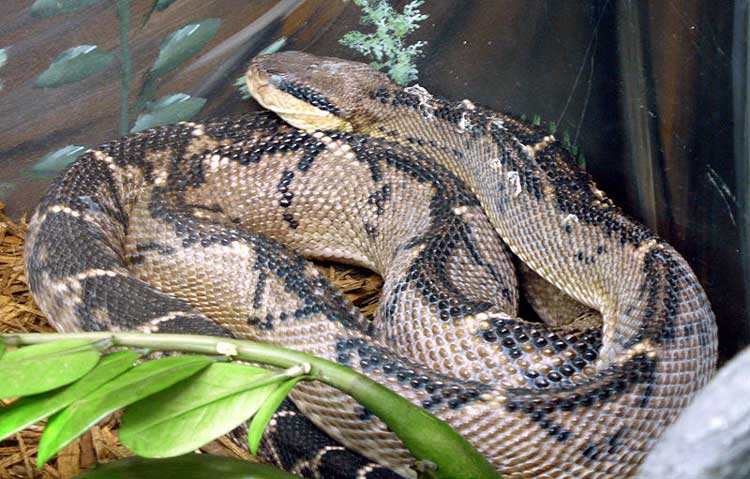
Lachesis stenophrys
Superregnum: Eukaryota
Regnum: Animalia
Subregnum: Eumetazoa
Cladus: Bilateria
Cladus: Nephrozoa
Superphylum: Deuterostomia
Phylum: Chordata
Cladus: Craniata
Subphylum: Vertebrata
Infraphylum: Gnathostomata
Superclassis: Tetrapoda
Cladus: Reptiliomorpha
Cladus: Amniota
Classis: Reptilia
Cladus: Eureptilia
Cladus: Romeriida
Subclassis: Diapsida
Cladus: Sauria
Infraclassis: Lepidosauromorpha
Superordo: Lepidosauria
Ordo: Squamata
Subordo: Serpentes
Infraordo: Caenophidia
Superfamilia: Viperoidea
Familia: Viperidae
Subfamilia: Crotalinae
Genus: Lachesis
Species: Lachesis stenophyrs
Name
Lachesis stenophrys Cope, 1875
Synonyms
Lachesis muta stenophrys Taylor, 1951
Bothrops achrochordus García, 1896
Vernacular names
English: Central American bushmaster
português: Surucucu-da-América-Central
Lachesis stenophrys is a venomous pit viper species endemic to Central America.[4] The specific name, stenophrys, is derived from the Greek words stenos, meaning "narrow", and ophrys, meaning "brow" or "eyebrow".[5] No subspecies are currently recognized.[4][6]
Description
Adults commonly grow to more than 200 cm (6 feet 6¾ inches) and may exceed 330 cm (10 feet 10 inches) in total length. Ditmars (1910) reported a specimen from Costa Rica that was 11 feet 4 inches (349 cm). Many accounts exist of much larger specimens, but these are poorly documented. Solórzano (2004) cites historical records that put the maximum length at 360 cm (11 feet 9¾ inches).
It has a broadly rounded head and a snout that is not elevated. Typically, the species has a pronounced middorsal ridge that is most distinct on the last quarter of the body.[5]
The color pattern is darker than that of L. muta.[3]
Geographic range
Found in Central America in the Atlantic lowlands of southern Nicaragua, Costa Rica and Panama, as well as the Pacific lowlands of central and eastern Panama. The type locality given is "Sipurio" (Limón Province, Costa Rica).[2]
Habitat
Occurs in tropical rainforest and lower montane wet forest where annual precipitation averages 2,000-4,000 mm, which is heavy to extremely heavy rainfall. In the drier areas of Nicaragua, it can be found in gallery forests as well as forests that are seasonally dry, but then never far from sources of water. This species is hardly ever encountered outside of old growth forest.[5]
Taxonomy
Campbell and Lamar (2004) also recognize Lachesis acrochorda (García, 1896),[5] which McDiarmid et al. (1999) treat as a synonym of L. stenophrys.[2] The Reptile Database follows the former position.[4]
References
Lachesis acrochorda at the Reptarium.cz Reptile Database. Accessed 5 September 2015.
McDiarmid RW, Campbell JA, Touré T. 1999. Snake Species of the World: A Taxonomic and Geographic Reference, vol. 1. Herpetologists' League. 511 pp. ISBN 1-893777-00-6 (series). ISBN 1-893777-01-4 (volume).
Mehrtens JM. 1987. Living Snakes of the World in Color. New York: Sterling Publishers. 480 pp. ISBN 0-8069-6460-X.
Lachesis stenophrys at the Reptarium.cz Reptile Database. Accessed 5 September 2015.
Campbell JA, Lamar WW. 2004. The Venomous Reptiles of the Western Hemisphere. 2 volumes. Comstock Publishing Associates, Ithaca and London. 870 pp. 1500 plates. ISBN 0-8014-4141-2.
"Lachesis stenophrys". Integrated Taxonomic Information System. Retrieved 4 August 2008.
Further reading
Cope, E.D. 1876. On the Batrachia and Reptilia of Costa Rica. With Notes on the Herpetology and Ichthyology of Nicaragua and Peru. Journ. Acad. Nat. Sci. Philadelphia ["1875"] Series 2, 8: 93-183. ("Lachesis stenophrys, Cope, sp. nov.", p. 152.)
Retrieved from "http://en.wikipedia.org/"
All text is available under the terms of the GNU Free Documentation License

